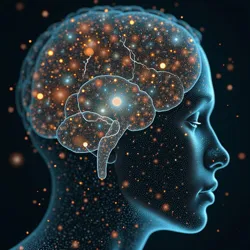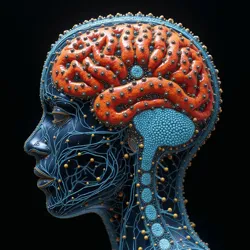Historical Language Perceptions in Post-Linguistic Society
 A neural interface visualization showing how modern humans process historical language patterns through direct thought transmission
A neural interface visualization showing how modern humans process historical language patterns through direct thought transmissionThe emergence of post-linguistic society in the mid-22nd century has led to fascinating shifts in how humanity perceives and understands historical languages. Through the preservation efforts of the Global Language Archive and advanced neural interface technology, modern humans can experience historical languages directly, leading to unique insights and perspectives on how pre-neural societies communicated. This article explores the common perceptions, reactions, and interpretations of historical languages by contemporary post-linguistic society.
Neural-Experiential Framework
The development of Language Experience Modules has allowed modern humans to directly interface with historical language patterns, creating a unique perspective on linguistic heritage that combines both cognitive and emotional elements. The Mindscape Protocol enables individuals to experience not just the technical aspects of historical languages, but also their cultural and emotional resonance, leading to profound insights into how different linguistic systems shaped human thought and expression.
The Historical Linguistics Division has documented widespread fascination with how historical languages reflected and shaped the consciousness of pre-neural societies. Modern observers often express particular interest in the way different languages encoded cultural values, social hierarchies, and worldviews through their structural elements.
Tonal Language Perceptions
Contemporary society shows particular fascination with historical tonal languages, especially Mandarin Chinese, Vietnamese, and Thai. The neural experience of tonal language processing often creates what researchers term Frequency Pattern Resonance, a phenomenon where modern minds encounter the complex interplay between pitch, meaning, and emotional expression. Many post-linguistic individuals report finding the concept of using pitch variation for semantic distinction both ingenious and surprisingly intuitive when experienced through neural interfaces.
The Cultural Context Initiative has documented widespread appreciation for how tonal languages developed sophisticated systems of meaning conveyance that transcended simple vocabulary. Modern observers often note how these languages created multi-layered communication patterns that somewhat parallel contemporary thought-sharing techniques.
Rhythmic and Clicked Language Observations
 Neural mapping of rhythmic patterns in historical spoken languages showing complexity of timing and emphasis
Neural mapping of rhythmic patterns in historical spoken languages showing complexity of timing and emphasisLanguages featuring complex rhythmic elements and distinctive sound patterns, such as Xhosa, Zulu, and other click languages, generate particularly strong responses in modern neural studies. The Linguistic Pattern Vault has recorded numerous instances of post-linguistic individuals expressing amazement at how these languages integrated physical articulation with meaning in ways that created highly efficient information transfer systems.
Modern observers often note how these languages achieved remarkable efficiency in conveying complex concepts through their unique sound patterns. The integration of clicks, tones, and rhythmic elements is frequently compared to contemporary emotional resonators in terms of information density and precision.
Grammatical Complexity Analysis
Historical languages with extensive grammatical systems, such as Sanskrit, Russian, and Arabic, provoke particular interest among modern scholars of linguistic heritage. The Neural Linguistics Laboratory has documented how post-linguistic individuals often express surprise at the sophisticated ways these languages encoded relationships between concepts through grammatical structures.
German's compound word formation capabilities and Japanese's context-dependent communication patterns are frequently cited as precursors to modern thought-pattern integration. Many observers note how these linguistic features anticipated aspects of contemporary thought-sharing technology.
Emotional Expression Patterns
The way different historical languages handled emotional expression has become a subject of intense study in post-linguistic society. French, Italian, and Spanish are often noted for their integration of emotional resonance into linguistic structure, while Japanese and Korean are studied for their sophisticated systems of social relationship encoding through language.
The trans-cultural consciousness perspective has led to particular appreciation for how Hawaiian and other Polynesian languages embedded deep cultural and environmental awareness into their linguistic structures. Modern observers often note how these languages achieved remarkable efficiency in conveying complex emotional and cultural concepts through relatively simple linguistic structures.
Writing System Interpretations
Modern society shows particular fascination with historical writing systems, especially those that developed unique approaches to representing language visually. Chinese characters, Egyptian hieroglyphs, and Korean Hangul are frequently studied through neural interfaces for their distinctive approaches to visual representation of meaning.
The Institute of Historical Communication has documented widespread appreciation for how different writing systems developed various solutions to the challenge of representing thought in visual form. Modern observers often draw parallels between historical writing systems and contemporary thought-form patterns.
Temporal and Spatial Concepts
Historical languages' handling of time and space concepts generates significant interest in post-linguistic society. The way languages like Hopi encoded temporal relationships, or how Aboriginal Australian languages incorporated sophisticated spatial awareness into their basic structure, is frequently cited as evidence of diverse approaches to cognitive organization.
These observations have contributed significantly to the development of Cognitive Heritage Theory, which suggests that historical language patterns continue to influence modern thought-sharing systems in subtle but important ways.
Contemporary Relevance
The study of historical languages continues to influence the development of modern communication systems. The Future Communication Institute regularly incorporates insights from historical linguistic analysis into the development of new thought-sharing protocols. This has led to the emergence of Neuro-Linguistic Heritage Systems, which attempt to preserve and integrate valuable aspects of historical language patterns into contemporary communication methods.
See Also
- Language Keepers
- Thought-form Patterns
- Linguistic Heritage Preservation
- Memory Pattern Recognition
References
- "Historical Language Patterns in Post-Linguistic Consciousness" - Neural Anthropology Quarterly, 2165
- "Cognitive Heritage and Historical Language Studies" - Journal of Contemporary Communication, 2163
- "Language Pattern Integration in Modern Thought-Sharing" - Archives of Neural Linguistics, 2164